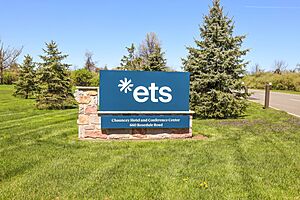Educational Testing Service facts for kids

ETS logo used since 2024
|
|
| 501(c)(3) | |
| Founded | 1947 |
| Headquarters | 660 Rosedale Road, Princeton, New Jersey, U.S. |
|
Key people
|
|
| Products | TOEFL and TOEIC tests, GRE General and Subject Tests, CET1 Exam by Certtia tests and Praxis Series assessments |
| Services | Testing, assessments and research for educational use |
| Subsidiaries |
|
Educational Testing Service (ETS) is a big organization that creates and gives out important tests for students and professionals. It was started in 1947 and is the largest private group of its kind in the world. ETS has its main office in Lawrence Township, New Jersey, which is close to Princeton.
ETS creates many different standardized tests. These tests are used in schools from kindergarten all the way through college and beyond. They also manage international tests like the TOEFL (Test of English as a Foreign Language) and TOEIC (Test of English for International Communication). Other well-known tests include the Graduate Record Examination (GRE) and The Praxis test Series. ETS gives these tests in over 180 countries at more than 9,000 locations.
Many ETS tests help students get into colleges and universities in the U.S. They also create tests for K–12 schools in many states, like California and Texas. Each year, ETS manages about 50 million exams in the U.S. and around the world.
Contents
How ETS Started: A Brief History
ETS is a non-profit organization. This means it uses its money to support its mission, not to make a profit for owners. It was created in 1947 by three other non-profit education groups: the American Council on Education, The Carnegie Foundation for the Advancement of Teaching, and The College Entrance Examination Board.
These groups formed ETS to handle their testing programs. They also wanted ETS to do research to make educational testing better. For example, the Carnegie Foundation gave ETS the GRE test, and the College Board asked ETS to run the SAT test for high school students.
Amazing Discoveries in Testing and Learning
ETS has always focused on research. They study how to measure learning and how people learn. Their research covers areas like statistics, how to evaluate education, and different types of psychology. Many smart people have worked at ETS and made big contributions to their fields.
Some important scientists at ETS helped create new ways to understand tests. For example, they helped develop:
- Item Response Theory: This is a way to design and analyze tests better.
- Structural Equation Modeling: This helps researchers understand how different things are connected in studies.
- Modern Validity Theory: This idea helps make sure tests truly measure what they are supposed to measure.
- Methods for Missing Data: They found ways to analyze information even when some data is missing.
- Causal Modeling: This helps figure out cause-and-effect relationships from observations.
- The In-Basket Test: This test helps assess people applying for management jobs.
- Detecting Test Unfairness: They developed ways to find out if a test is unfair to certain groups.
- Holistic Scoring for Writing: This is a fast and reliable way to grade essays.
Many ETS staff members have won important awards and led major organizations in the field of education and psychology. Their work has helped improve how tests are made and used all over the world.
Where ETS Works Today
ETS has its international headquarters on a large campus near Princeton, New Jersey. They also have offices in other U.S. cities like San Antonio, Texas, and Philadelphia, Pennsylvania.
Around the world, ETS has offices in places like Amsterdam, London, Seoul, Paris, Beijing, and Delhi. These international offices are part of smaller companies owned by ETS. Overall, ETS employs about 2,700 people, including many with advanced degrees.
About a quarter of ETS's work is for the College Board. The College Board is another non-profit group that works with universities and schools. ETS helps run the SAT test, which over 3 million students take every year. They also support the PSAT/NMSQT and the Advanced Placement (AP) program, which lets high school students earn college credit.
Since 1983, ETS has also worked on the National Assessment of Educational Progress (NAEP), often called the "Nation's Report Card." This is the only national test that shows what U.S. students know and can do. ETS helps create the test questions and analyze the results.
Besides working for other groups, ETS also offers its own tests. These include:
- The Graduate Record Examinations (GRE) for graduate school admissions.
- The Test of English as a Foreign Language (TOEFL) for college admissions.
- The Test of English for International Communication (TOEIC) for businesses.
- The Praxis Series for teachers to get their licenses.
Tests You Might Know
ETS creates or helps with many important tests. Here are some of them:
- Graduate Record Examinations (GRE)
- Preliminary SAT/National Merit Scholarship Qualifying Test (PSAT/NMSQT)
- College Level Examination Program (CLEP)
- Test of English as a Foreign Language (TOEFL)
- Test of English for International Communications (TOEIC)
- Certified English Test One (CET1)
- Test de français international (TFI)
- California High School Exit Exam (CAHSEE)
- California Standardized Testing and Reporting (STAR) Program – replaced by CAASPP in 2015.
- The Praxis test (for teachers)
- The National Assessment of Educational Progress (NAEP)
- The Examen de Admisión a Estudios de Posgrado (EXADEP)
- British Trade Test Institute (BTTI)
- Major Field Test for Master of Business Administration
See also
- SAT
- SPEAK (test)




